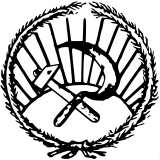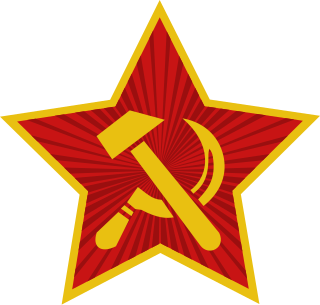
The Communist Party of Germany was a major far-left political party in the Weimar Republic during the interwar period, an underground resistance movement in Nazi Germany, and a minor party in West Germany during the postwar period until it was banned by the Federal Constitutional Court in 1956.
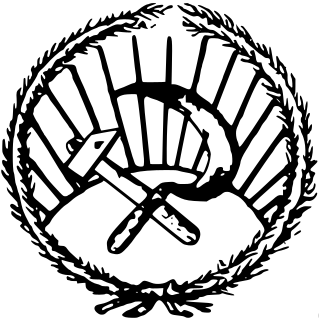
Council communism or Councilism is a current of communist thought that emerged in the 1920s. Inspired by the November Revolution, council communism was opposed to state socialism and advocated workers' councils and council democracy. It is regarded as being strongest in Germany and the Netherlands during the 1920s.

The Socialist Workers' Party of Germany was a centrist Marxist political party in Germany. It was formed as a left-wing party with around 20,000 members which split off from the SPD in the autumn of 1931. In 1931, the remnants of Independent Social Democratic Party of Germany (USPD) merged into the party and in 1932 some Communist Party dissenters also joined the group as well as a part from the Communist Party Opposition. Nevertheless, its membership remained small. From 1933, the group's members worked illegally against Nazism.
In Marxism, ultra-leftism encompasses a broad spectrum of revolutionary communist currents that are generally Marxist and frequently anti-Leninist in perspective. Ultra-leftism distinguishes itself from other left-wing currents through its rejection of electoralism, trade unionism, and national liberation. The term is sometimes used as a synonym of left communism. "Ultra-left" is also commonly used as a pejorative by Marxist–Leninists and Trotskyists to refer to extreme or uncompromising Marxist sects.
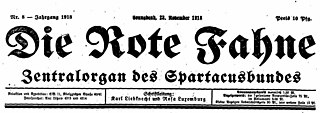
Die Rote Fahne was a German newspaper originally founded in 1876 by Socialist Worker's Party leader Wilhelm Hasselmann, and which has been since published on and off, at times underground, by German Socialists and Communists. Karl Liebknecht and Rosa Luxemburg famously published it in 1918 as organ of the Spartacus League.

The Iron Front was a German paramilitary organization in the Weimar Republic which consisted of social democrats, trade unionists, and democratic socialists. Its main goal was to defend social democracy against what was viewed as totalitarian ideologies on the far-right and far-left. The Iron Front chiefly opposed the Sturmabteilung (SA) wing of the Nazi Party and the Antifaschistische Aktion wing of the Communist Party of Germany. Formally independent, it was intimately associated with the Social Democratic Party of Germany (SPD). The Three Arrows, originally designed for the Iron Front, became a well-known social democratic symbol representing resistance against monarchism, Nazism, and Marxism-Leninism during the parliamentary elections in November 1932. The Three Arrows were later adopted by the SPD itself.

Richard Müller was a German socialist, metal worker, union shop steward, and later historian. Trained as a lathe-operator, Müller later became an industrial unionist and organizer of mass-strikes against World War I. In 1918 he was a leading figure of the council movement in the German Revolution. In the 1920s he wrote a three-volume history of the German Revolution.

Werner Scholem was a member of the German Reichstag from 1924 to 1928 and a leading member of the Communist Party of Germany. Scholem and his wife, Emmy, were portrayed in the 2014 documentary "Between Utopia and Counter Revolution".

The Rote Hilfe was the German affiliate of the International Red Aid. The Rote Hilfe was affiliated with the Communist Party of Germany and existed between 1924 and 1936. Its purpose was to provide help to those Communists who had been jailed or were imprisoned.
During the First World War (1914–1918), the Revolutionary Stewards were shop stewards who were independent from the official unions and freely chosen by workers in various German industries. They rejected the war policies of the German Empire and the support which parliamentary representatives of the Social Democratic Party (SPD) gave to the policies. They also played a role during the German Revolution of 1918–19.
Das Volksrecht was a left-wing newspaper published from Offenbach am Main, Weimar Germany between 1925 and 1933. Initially it was an irregular publication of the communist city council group, but in 1928 it became a local mouthpiece of the Right Opposition. It was published on a weekly basis until the National Socialist takeover in 1933.

The Spartacus League was a Marxist revolutionary movement organized in Germany during World War I. It was founded in August 1914 as the International Group by Rosa Luxemburg, Karl Liebknecht, Clara Zetkin, and other members of the Social Democratic Party of Germany (SPD) who were dissatisfied with the party's official policies in support of the war. In 1916 it renamed itself the Spartacus Group and in 1917 joined the Independent Social Democratic Party of Germany (USPD), which had split off from the SPD as its left wing faction.
Albert Schreiner was a German political activist and Marxist historian.
Maria Backenecker was a German politician (KPD) and feminist activist. She was elected to the Reichstag in 1924, but was expelled from the party early in 1927 during the course of one of its periodic outbursts of internal division. Her life and political career were cut short by Tuberculosis.

International Communists of Germany was a Communist political grouping founded in November 1918 during the German Revolution. The small party was, together with the better known Spartacist League, one of the constituent organizations that joined to form the Communist Party of Germany in 1918.

The Left Communists were a group of members of the Reichstag and the Prussian Landtag expelled from the Communist Party of Germany (KPD) in the period 1926–1928.
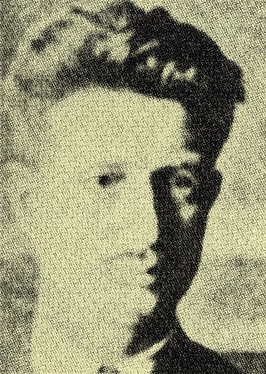
Hugo Urbahns was a German communist revolutionary and politician.
The Weddinger opposition was a group of the ultra-left wing of the Communist Party of Germany (KPD) that was formed in 1924. From 1928 onwards, the KPD leadership acted with numerous party expulsions against the group, which had been organized as a parliamentary group in the KPD since 1926. The group had around 2000 members in 1927; their strongholds were in the Berlin district of Wedding, in the Palatinate, which belongs to Bavaria, and in western Saxony.
The Communist Working Group was a short-lived political party in Germany during the Weimar Republic that existed from 1921 to 1922. Created by the former head of the Communist Party, Paul Levi, the organization was formed following his ousting in response to criticism of the March uprising. In 1922, the KAG merged with the USPD.
